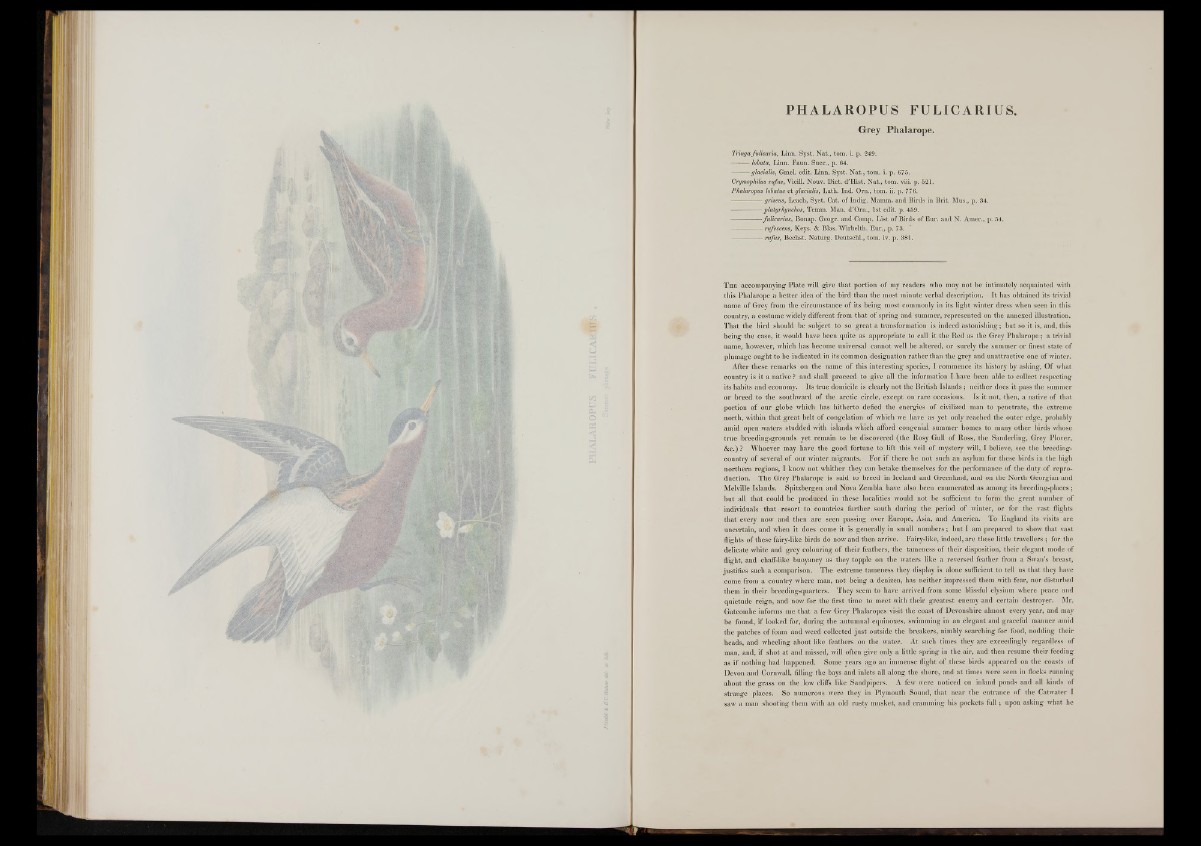
PHALAROPUS FULICARIUS.
Grey Phalarope.
Tringa fulicaria, Linn. Syst. Nat., tom. i. p. 249.
lobata, Linn. Faun. Suec., p. 64.
glacialis, Gmel. edit. Linn. Syst. Nat., tom. i. p. 675.
Crymophilus ru/us, Vieill. Nouv. Diet. d’Hist. Nat., tom. viii. p. 521.
Phalaropus lobatus et glacialis, Lath. Ind. Om., tom. ii. p. 776.
— griseus, Leach, Syst. Cat. of Indig. Mamm. and Birds in Brit. Mus., p. 34.
--------------platyrhynchos, Temm. Man. d’Orn., 1st edit. p. 459.
------------ fulicarius, Bonap. Geogr. and Comp. List of Birds of Eur. and N. Amer., p. 54.
--------------rufescens, Keys. & Bias. Wirbelth. Eur., p. 73.
— rufus, Bechst. Naturg. Deutschl., tom. iv. p. 381.
T h e accompanying Plate will give that portion of my readers who may not be intimately acquainted with
this Phalarope a better idea of the bird than the most minute verbal description. I t has obtained its trivial
name of Grey from the circumstance o f its being most commonly in its light winter dress when seen in this
country, a costume widely different from that of spring and summer, represented on the annexed illustration.
That the bird should be subject to so great a transformation is indeed astonishing; but so it is, and, this
being the case, it would have been quite as appropriate to call it the Red as the Grey Phalarope; a trivial
name, however, which has become universal cannot well be altered, or surely the summer or finest state of
plumage ought to be indicated in its common designation rather than the grey and unattractive one o f winter.
After these remarks on the name o f this interesting species, I commence its history by asking, Of what
country is it a native ? and shall proceed to give all the information I have been able to collect respecting
its habits and economy. Its true domicile is clearly not the B ritish Islands; neither does it pass the summer
or breed to the southward of the arctic circle, except on rare occasions. Is it not, then, a native of that
portion of our globe which has hitherto defied the energies o f civilized man to penetrate, the extreme
north, within that great belt of congelation o f which we have as yet only reached the outer edge, probably
amid open waters studded with islands which afford congenial summer homes to many other birds whose
true breeding-grounds yet remain to be discovered (the Rosy Gull of Ross, the Sanderling, Grey Plover,
&c.) ? Whoever may have the good fortune to lift this veil of mystery will, I believe, see the breeding-
country of several o f our winter migrants. For if there be not such an asylum for these birds in the high
northern regions, I know not whither they can betake themselves for the performance of the duty of reproduction.
The Grey Phalarope is said to breed in Iceland and Greenland, and on the North Georgian and
Melville Islands. Spitzbergen and Nova Zembla have also been enumerated as among its breeding-places ;
but all that could be produced in these localities would not be sufficient to form the great number of
individuals th at resort to countries further south during the period of winter, or for the vast flights
that every now and then are seen passing over Europe, Asia, and America. To England its visits are
uncertain, and when it does come it is generally in small numbers; but I am prepared to show that vast
flights o f these fairy-like birds do now and then arrive. Fairy-like, indeed, are these little travellers ; for the
delicate white and grey colouring o f their feathers, the tameness of their disposition, their elegant mode of
flight, and chaff-like buoyancy as they topple on the waters like a reversed feather from a Swan’s breast,
justifies such a comparison. The extreme tameness they display is alone sufficient to tell us that they have
come from a country where man, not being a denizen, has neither impressed them with fear, nor disturbed
them in their breeding-quarters. They seem to have arrived from some blissful elysium where peace and
quietude reign, and now for the first time to meet with their greatest enemy and certain destroyer. Mr.
Gatcombe informs me th at a few Grey Phalaropes visit the coast of Devonshire almost every year, and may
be found, if looked for, during the autumnal equinoxes, swimming in an elegant and graceful manner amid
the patches o f foam and weed collected ju st outside the breakers, nimbly searching for food, nodding their
heads, and wheeling about like feathers on the water. At such times they are exceedingly regardless of
man, and, if shot at and missed, will often give only a little spring in the air, and then resume their feeding
as if nothing had happened. Some years ago an immense flight o f these birds appeared on the coasts of
Devon and Cornwall, filling the bays and inlets all along the shore, and at times were seen in flocks running
about the grass on the low cliffs like Sandpipers. A few were noticed on inland ponds and all kinds of
strange places. So numerous were they in Plymouth Sound, th at near the entrance o f the Catwater I
saw a man shooting them with an old rusty musket, and cramming his pockets fu ll; upon asking what he